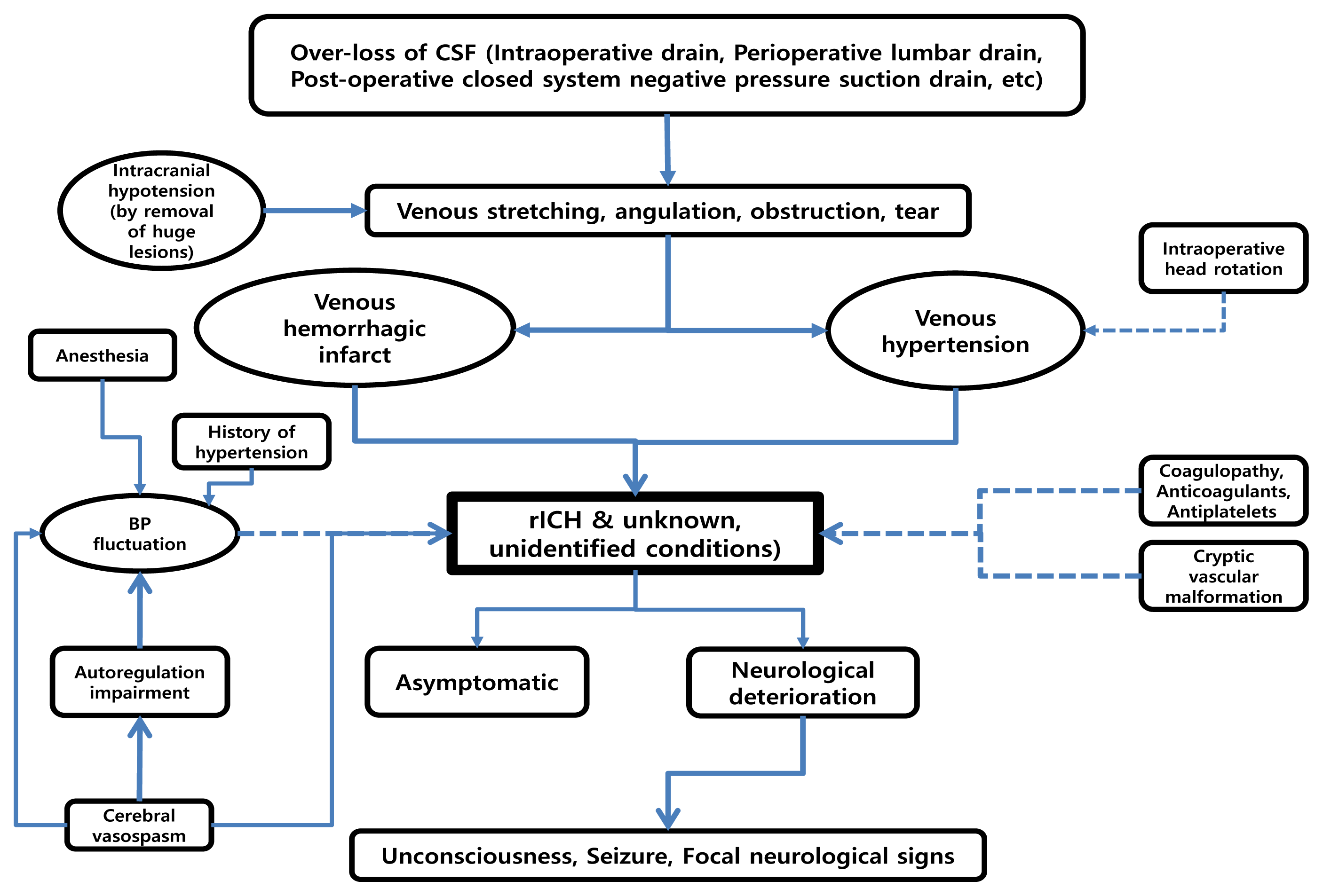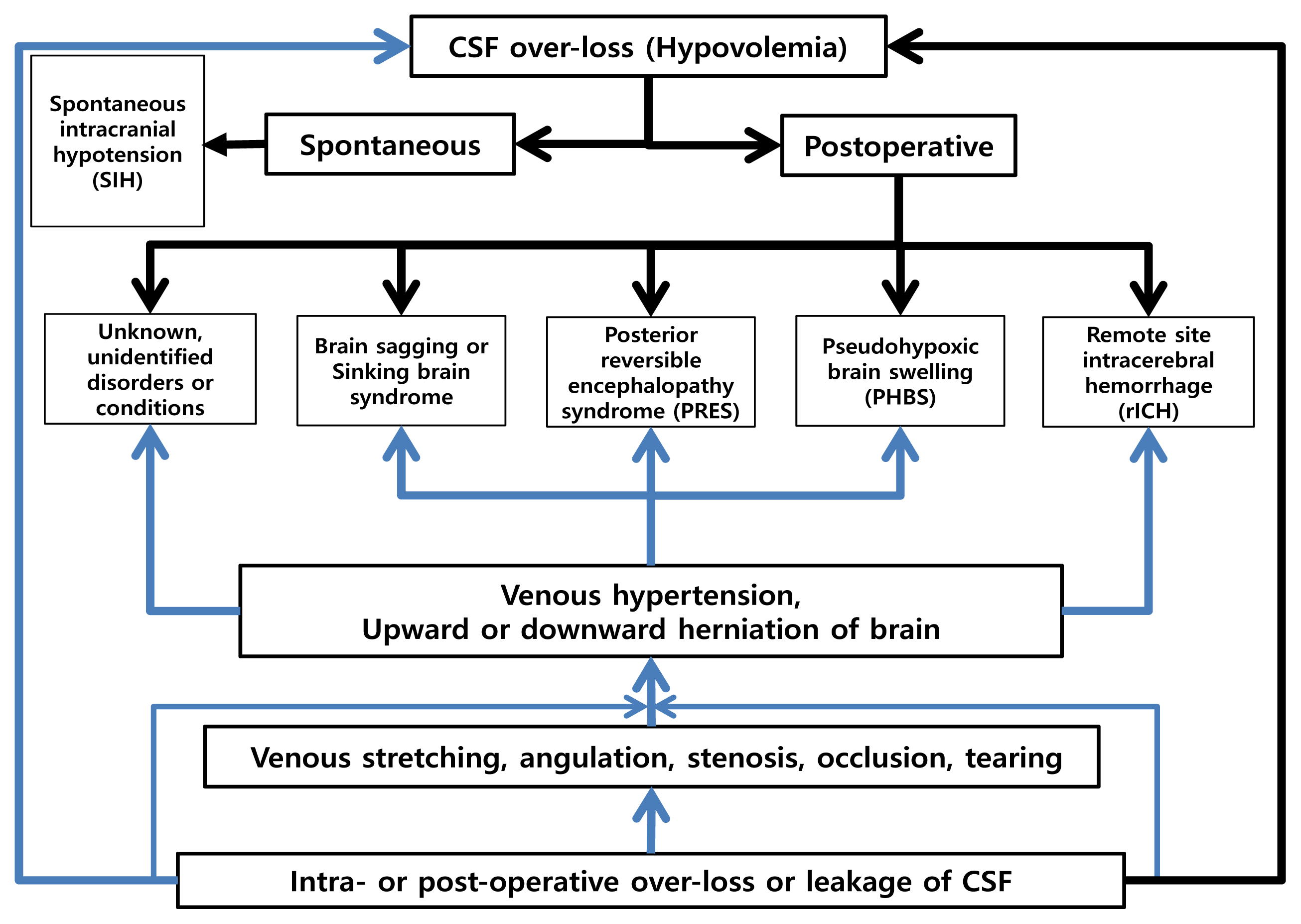1. Atkinson JL, Weinshenker BG, Miller GM, Piepgras DG, Mokri B. Acquired Chiari I malformation secondary to spontaneous spinal cerebrospinal fluid leakage and chronic intracranial hypotension syndrome in seven cases. J Neurosurg. 1998; Feb. 88(2):237–42.

2. Baek IH, Park KY, Lee JW, Huh SK. Remote cerebellar hemorrhage after surgery for an unruptured aneurysm. J Cerebrovasc Endovasc Neruosurg. 2008; Sep. 10(3):454–8.
3. Basauri LT, Concha-Julio E, Selman JM, Cubillos P, Rufs J. Cerebrospinal fluid spinal lumbar drainage: indications, technical tips, and pitfalls. Crit Rev Neurosurg. 1999; Jan. 9(1):21–7.

4. Borkar SA, Lakshmiprasad G, Sharma BS, Mahapatra AK. Remote site intracranial haemorrhage: a clinical series of five patients with review of literature. Br J Neurosurg. 2013; Dec. 27(6):735–8.

5. Brisman MH, Bederson JB, Sen CN, Germano IM, Moore F, Post KD. Intracerebral hemorrhage occurring remote from the craniotomy site. Neurosurgery. 1996; Dec. 39(6):1114–1121. discussion 1121–2.

6. Chang SH, Yang SH, Son BC, Lee SW. Cerebellar hemorrhage after burr hole drainage of supratentorial chronic subdural hematoma. J Korean Neurosurg Soc. 2009; Dec. 46(6):592–5.

7. Delgado-López PD, Garcés-Pérez G, García-Carrasco J, Alonso-García E, Gómez-Menéndez AI, Martín-Alonso J. Posterior reversible encephalopathy syndrome with status epilepticus following surgery for lumbar stenosis and spondylolisthesis. World Neurosurg. 2018; Aug. 116:309–15.

8. Doddamani RS, Sawarkar D, Meena RK, Gurjar H, Singh PK, Singh M, et al. Remote cerebellar hemorrhage following surgery for supratentorial lesions. World Neurosurg. 2019; Jun. 126:e351–9.

9. Friedman JA, Ecker RD, Piepgras DG, Duke DA. Cerebellar hemorrhage after spinal surgery: report of two cases and literature review. Neurosurgery. 2002; Jun. 50(6):1361–3. discussion 1363–4.

10. Friedman JA, Piepgras DG, Duke DA, McClelland RL, Bechtle PS, Maher CO, et al. Remote cerebellar hemorrhage after supratentorial surgery. Neurosurgery. 2001; Dec. 49(6):1327–40.

11. Honeybul S. Sudden death after cranioplasty. J Korean Neurosurg Soc. 2016; Mar. 59(2):182–4.
12. Kalfas IH, Little JR. Postoperative hemorrhage: a survey of 4992 intracranial procedures. Neurosurgery. 1988; Sep. 23(3):343–7.

13. Kang YG, Chung H, Lee SP, Choi KH, Yeo HT, Rhee JK. Remote intracerebral hematoma after supratentorial craniotomy. J Korean Neurosurg Soc. 1996; Sep. 25(9):1910–6.
14. Kasuya H, Shimizu T, Kagawa M. The effect of continuous drainage of cerebrospinal fluid in patients with subarachnoid hemorrhage: a retrospective analysis of 108 patients. Neurosurgery. 1991; Jan. 28(1):56–9.

15. Kassell NF, Sasaki T, Colohan ART, Nazar G. Cerebral vasospasm following aneurysmal subarachnoid hemorrhage. Stroke. 1985; Jul–Aug. 16(4):562–72.

16. Kassell NF, Torner JC, Haley EC Jr, Jane JA, Adams HP, Kongable GL, et al. The international cooperative study on the timing of aneurysm surgery. Part 1: Overall management results. J Neurosurg. 1990; Jul. 73(1):18–36.
17. Katsevman GA, Turner RC, Cheyuo C, Rosen CL, Smith MS. Post-partum posterior reversible encephalopathy syndrome requiring decompressive craniectomy: case report and review of the literature. Acta Neurochir (Wien). 2019; Feb. 161(2):217–24.

18. Kim SH, Lee HK, Moon JK, Kim CH, Choi JH. Remote cerebellar hemorrhage after supratentorial aneurysm surgery; report of 2 cases. J Cerebrovasc Endovasc Neruosurg. 2008; Dec. 10(4):570–4.
19. Komotar RJ, Ransom ER, Mocco J, Zacharia BE, McKhann GM 2nd, Mayer SA, et al. Critical postcraniotomy cerebrospinal fluid hypovolemia: risk factors and outcome analysis. Neurosurgery. 2006; Aug. 59(2):284–90.
20. Lee JW, Yim MB, Lee JC, Son EI, Kim DW, Kim IH. Intracerebral hemorrhage remote from the site of aneurysm surgery. J Korean Neurosurg Soc. 1996; Apr. 25(4):834–41.
21. Liu JKC. Neurologic deterioration due to brain sag after bilateral craniotomy for subdural hematoma evacuation. World Neurosurg. 2018; Jun. 114:90–3.

22. Mandonnet E, Faivre B, Bresson D, Cornelius J, Guichard JP, Houdart E, et al. Supratentorial craniotomy complicated by an homolateral remote cerebellar hemorrhage and a controlateral perisylvian infarction: case report. Acta Neurochir (Wien). 2010; Jan. 152(1):169–72.

23. McDonald JV, Klump TE. Intraspinal epidermoid tumors caused by lumbar puncture. Arch Neurol. 1986; Sep. 43(9):936–9.

24. Motoyama Y, Nakajima T, Takamura Y, Nakazawa T, Wajima D, Takeshima Y, et al. Risk of brain herniation after craniotomy with lumbar spinal drainage: a propensity score analysis. J Neurosurg. 2018; Jun. 1–11.

25. Papanastassiou V, Kerr R, Adams C. Contralateral cerebellar hemorrhagic infarction after pterional craniotomy: report of five cases and review of the literature. Neurosurgery. 1996; Oct. 39(4):841–51. discussion 851–2.

26. Park CW. Postoperative cerebrospinal fluid hypovolemia in neurosurgery. J Neurointensive Care. 2018; 1(1):3–6.

27. Park SJ, Lee MK, Kim DJ. Supratentorial surgery complicated by cerebellar hemorrhage: report of three cases. J Korean Neurosurg Soc. 1997; Jul. 26(7):1011–6.
28. Samadani U, Huang JH, Baranov D, Zager EL, Grady MS. Intracranial hypotension after intraoperative lumbar cerebrospinal fluid drainage. Neurosurgery. 2003; Jan. 52(1):148–51. discussion 151–2.

29. Seoane E, Rhoton AL Jr. Compression of the internal jugular vein by the transverse process of the atlas as the cause of cerebellar hemorrhage after supratentorial craniotomy. Surg Neurol. 1999; May. 51(5):500–5.

30. Sturiale CL, Rossetto M, Ermani M, Baro V, Volpin F, Milanese L, et al. Remote cerebellar hemorrhage after spinal procedures (part 2): a systematic review. Neurosurg Rev. 2016; Jul. 39(3):369–76.

31. Sturiale CL, Rossetto M, Ermani M, Volpin F, Baro V, Milanese L, et al. Remote cerebellar hemorrhage after supratentorial procedures (part 1): a systematic review. Neurosurg Rev. 2016; Oct. 39(4):565–73.

32. Sviri GE. Massive cerebral swelling immediately after cranioplasty, a fatal and unpredictable complication: report of 4 cases. J Neurosurg. 2015; Nov. 123(5):1188–93.

33. van Calenbergh F, Goffin J, Plets C. Cerebellar hemorrhage complicating supratentorial craniotomy: report of two cases. Surg Neurol. 1993; Oct. 40(4):336–8.

34. van Roost D, Thees C, Brenke C, Oppel F, Winkler PA, Schramm J. Pseudohypoxic brain swelling: a newly defined complication after uneventful brain surgery, probably related to suction drainage. Neurosurgery. 2003; Dec. 53(6):1315–26. discussion 1326–7.

35. Waga S, Shimosaka S, Sakakura M. Intracerebral hemorrhage remote from the site of the initial neurosurgical procedure. Neurosurgery. 1983; Dec. 13(6):662–5.

36. Yasargil MG, Yonekawa Y. Results of microsurgical extra-intracranial arterial bypass in the treatment of cerebral ischemia. Neurosurgery. 1977; Jul–Aug. 1(1):22–4.

37. Yokota H, Yokoyama K, Miyamoto K, Nishioka T. Pseudohypoxic brain swelling after elective clipping of an unruptured anterior communicating artery aneurysm. Clin Neurol Neurosurg. 2009; Dec. 111(10):900–3.

38. You SH, Son KR, Lee NJ, Suh JK. Remote cerebral and cerebellar hemorrhage after massive cerebrospinal fluid leakage. J Korean Neurosurg Soc. 2012; Apr. 51(4):240–3.







 PDF
PDF Citation
Citation Print
Print



 XML Download
XML Download